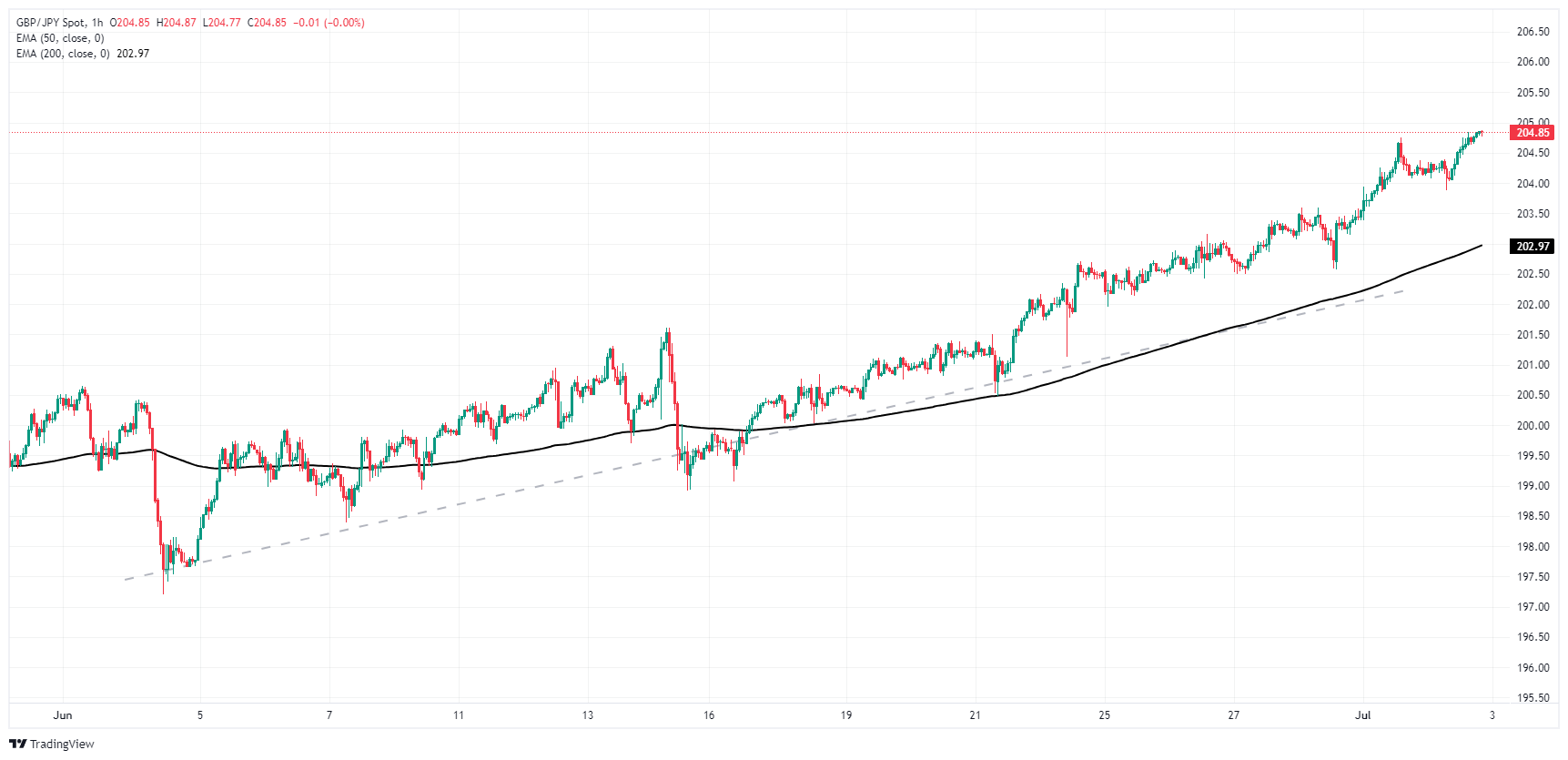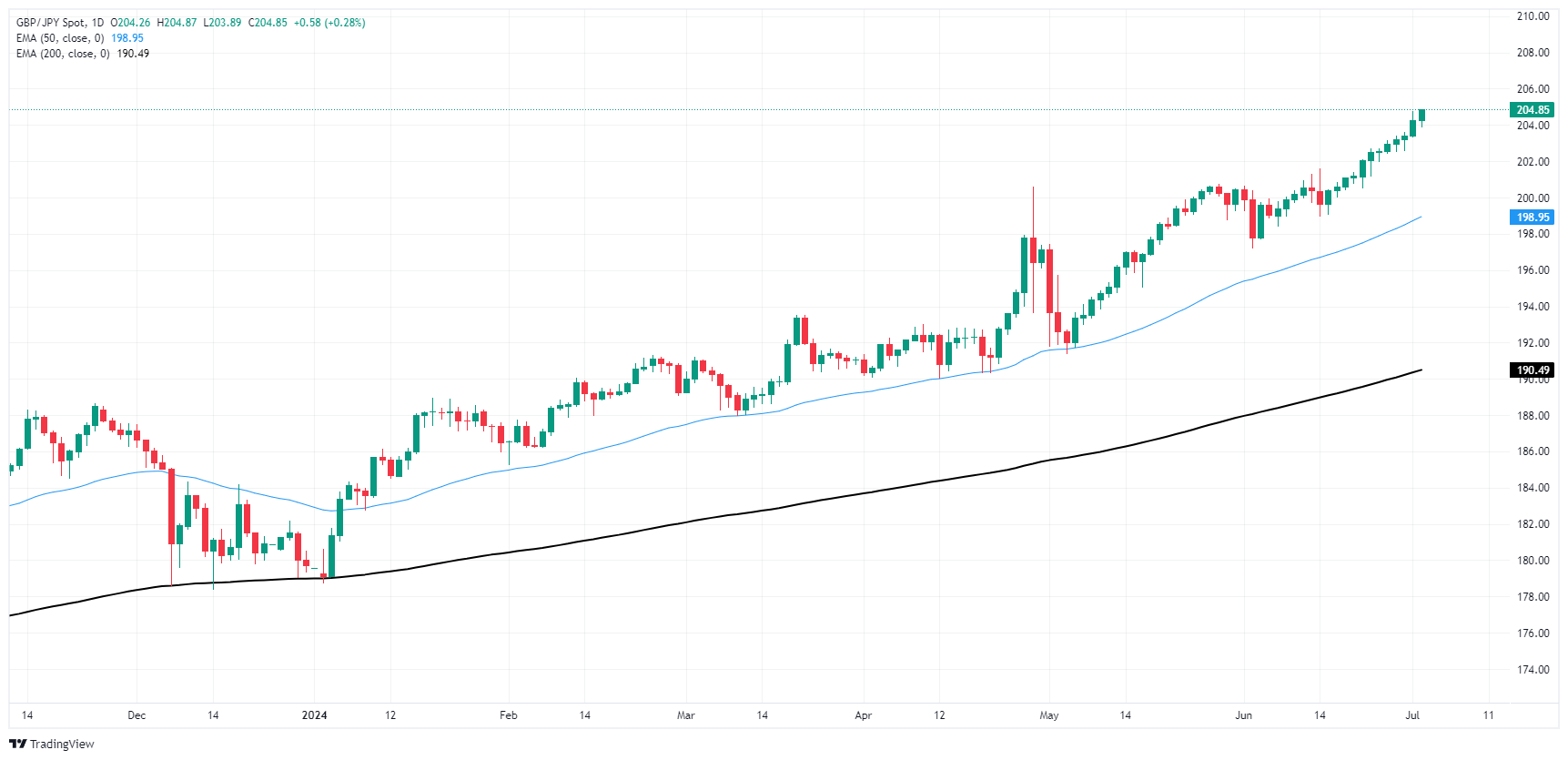- Analytics
- News and Tools
- Market News
- GBP/JPY continues march towards 205.00 as Yen declines extend
GBP/JPY continues march towards 205.00 as Yen declines extend
- GBP/JPY is on pace to clip into 205.00 as the pair machines through multi-year highs.
- A lack of notable data on Tuesday left the Guppy free to drift higher.
- UK Parliamentary Elections loom ahead on Thursday.
GBP/JPY drifted into yet another 16-year high on Tuesday, peaking near 204.85 as the pair continues to grind towards 205.00. The Japanese Yen is crumbling in broader FX markets as currency traders shrug off outright pleas and threats of direct intervention from the Bank of Japan (BoJ) and Japan’s Ministry of Finance (MoF).
Tuesday was notably light on data releases for both the GBP and the JPY, giving the Guppy room to breathe and test into fresh highs as bids continue to push into ground unseen since August of 2008. The economic calendar remains thin for both currencies through the remainder of the trading week, but UK Parliamentary Elections slated for Thursday could introduce some volatility into the election run-up and after results are tallied. The UK’s Labour Party is broadly expected to sweep to a majority win according to advance polling, and Labour’s Keir Starmer is expected to replace the Conservative Party’s Tory leader Rishi Sunak as the UK’s Prime Minister.
Japanese data remains notably thin looking to the weeks ahead, leaving Yen traders to keep an eye out for one-off statements from officials as JPY speculators hunker down for the long wait to the BoJ’s next rate call, slated for July 31.
GBP/JPY technical outlook
GBP/JPY continues to lean firmly bullish as intraday price gains accelerate into the top side. The pair is set to snap the 205.00 major price handle, and the pair would have to decline a full percent just to cross back into bearish territory below the 200-hour Exponential Moving Average (EMA) approaching 203.00.
The Guppy has closed in the green for 12 consecutive trading days, and a long-term bullish trend with few pullbacks has left the pair deep in bull country, trading well above significant technical levels at the 200-day EMA, way below current price action at 190.54.
GBP/JPY hourly chart
GBP/JPY daily chart
Pound Sterling FAQs
The Pound Sterling (GBP) is the oldest currency in the world (886 AD) and the official currency of the United Kingdom. It is the fourth most traded unit for foreign exchange (FX) in the world, accounting for 12% of all transactions, averaging $630 billion a day, according to 2022 data. Its key trading pairs are GBP/USD, aka ‘Cable’, which accounts for 11% of FX, GBP/JPY, or the ‘Dragon’ as it is known by traders (3%), and EUR/GBP (2%). The Pound Sterling is issued by the Bank of England (BoE).
The single most important factor influencing the value of the Pound Sterling is monetary policy decided by the Bank of England. The BoE bases its decisions on whether it has achieved its primary goal of “price stability” – a steady inflation rate of around 2%. Its primary tool for achieving this is the adjustment of interest rates. When inflation is too high, the BoE will try to rein it in by raising interest rates, making it more expensive for people and businesses to access credit. This is generally positive for GBP, as higher interest rates make the UK a more attractive place for global investors to park their money. When inflation falls too low it is a sign economic growth is slowing. In this scenario, the BoE will consider lowering interest rates to cheapen credit so businesses will borrow more to invest in growth-generating projects.
Data releases gauge the health of the economy and can impact the value of the Pound Sterling. Indicators such as GDP, Manufacturing and Services PMIs, and employment can all influence the direction of the GBP. A strong economy is good for Sterling. Not only does it attract more foreign investment but it may encourage the BoE to put up interest rates, which will directly strengthen GBP. Otherwise, if economic data is weak, the Pound Sterling is likely to fall.
Another significant data release for the Pound Sterling is the Trade Balance. This indicator measures the difference between what a country earns from its exports and what it spends on imports over a given period. If a country produces highly sought-after exports, its currency will benefit purely from the extra demand created from foreign buyers seeking to purchase these goods. Therefore, a positive net Trade Balance strengthens a currency and vice versa for a negative balance.
© 2000-2024. All rights reserved.
This site is managed by Teletrade D.J. LLC 2351 LLC 2022 (Euro House, Richmond Hill Road, Kingstown, VC0100, St. Vincent and the Grenadines).
The information on this website is for informational purposes only and does not constitute any investment advice.
The company does not serve or provide services to customers who are residents of the US, Canada, Iran, The Democratic People's Republic of Korea, Yemen and FATF blacklisted countries.
Making transactions on financial markets with marginal financial instruments opens up wide possibilities and allows investors who are willing to take risks to earn high profits, carrying a potentially high risk of losses at the same time. Therefore you should responsibly approach the issue of choosing the appropriate investment strategy, taking the available resources into account, before starting trading.
Use of the information: full or partial use of materials from this website must always be referenced to TeleTrade as the source of information. Use of the materials on the Internet must be accompanied by a hyperlink to teletrade.org. Automatic import of materials and information from this website is prohibited.
Please contact our PR department if you have any questions or need assistance at pr@teletrade.global.















